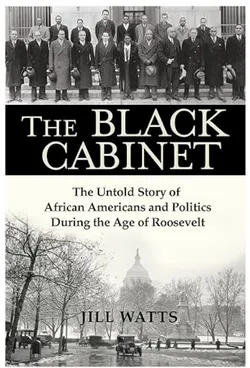
Beginning in 1929, the Great Depression included the stock market crash[1], coupled with bank failures[1], loss of jobs, massive droughts and international trade decline,[2] all of which took America to her lowest economic and emotional point. Governor Franklin Delano Roosevelt’s campaign promise to turn America around won him the Presidency on March 4, 1933. By implementing programs that were considered risky as well as innovative, honest work, not handouts, his far-reaching policies became known as The New Deal[3].
In an effort to make sure African Americans were included, The Black Cabinet[4], also known as the Federal Council on Negro Affairs was formed. By working from inside the government, this informal advisory group, made up of African American professionals, community leaders, scholars and activists aimed to ensure that African Americans received fair treatment and opportunities, despite ingrained systemic racism and political opposition. As the nation moved into World War II this became more important. Working closely with First Lady Eleanor Roosevelt[5] and white liberals, the Black Cabinet helped push for institutional support for racial justice within the New Deal administration. Secretary of Interior and former Chicago NAACP President Harold Ickes[6] led a campaign to open up high level civil service jobs to African Americans at a time when it was totally unheard of. At the same time, with the support of First Lady Eleanor Roosevelt, Mary McLeod Bethune[7], who served as an advisor on minority issues, and in 1939 was named Director of Negro Affairs, pushed for the admittance of African American women in the military. This led to more emphasis on the role of the Women’s Army Corps (WAC)[8] and the formation of the all-Black 6888th Central Postal Directory Battalion[9].
Research your ancestors on MyHeritage
Impact of the Black CabinetImpact of the Black Cabinet
The Black Cabinet lobbied for equal access to federal benefits, employment, and job training programs for African Americans. In June 1941, they helped the Roosevelt administration draft Executive Order 8802[10] directing that African Americans be accepted into job-training programs in defense plants, forbid discrimination by defense contractors, and established a Fair Employment Practices Commission (FEPC). The leaders associated with the Black Cabinet have often been credited with laying part of the foundation of the Civil Rights Movement.[11]
Prominent participants in the processProminent participants in the process
The following list is NOT all-inclusive but contains the names of other notable figures involved in the process:
See alsoSee also
Explore more about The Black CabinetExplore more about The Black Cabinet
- United States military records collection at MyHeritage
- New Deal Agencies and Black America. LexisNexis
- Harold L. Ickes (1933–1945). MillerCenter.org
- President Franklin D. Roosevelt’s “Black Cabinet” taken in 1938. Smithsonian. National Museum of American History
- FDR's Fireside Chat on the Recovery Program. National Archives
- Rediscovering Black History. Providing a New Deal for Young Black Women: Mary McLeod Bethune and the Negro Affairs Division of the NYA. National Archives
- Eastern Region of Alpha Phi Alpha Fraternity. AlphaEast.com.
- Burke, Kevin M., Robert Heinrich, and Steven J. Niven. The Roosevelts and African American Civil Rights Leaders. Hutchins Center for African & African American Research at Harvard University, in association with the National Park Service
- Tidwell, John Edgar. Recasting Negro Life History: Sterling A. Brown and the Federal Writer’s Project. The Langston Hughes Review 13, no. 2 (1995): 77–82.
- Black Cabinet Facts for Kids. Kiddle.com. Kidpedia
- Watts, Jill. The Black Cabinet: The Untold Story of African Americans and Politics During the Age of Roosevelt. New York: Grove Press, 2020
- All Of It. WNYC Studios
References
- ↑ 1.0 1.1 Stock Market Crash of 1929. History Channel
- ↑ What Is the Smoot-Hawley Tariff Act? History, Effect and Reaction. Investopedia
- ↑ https://www.loc.gov/classroom-materials/united-states-history-primary-source-timeline/great-depression-and-world-war-ii-1929-1945/franklin-delano-roosevelt-and-the-new-deal/
- ↑ https://www.history.com/news/franklin-roosevelt-black-cabinet-bethune
- ↑ https://www.fdrlibrary.org/er-biography
- ↑ https://www.nps.gov/people/harold-ickes.htm
- ↑ https://www.womenshistory.org/education-resources/biographies/mary-mcleod-bethune
- ↑ https://www.britannica.com/topic/Womens-Army-Corps
- ↑ https://www.history.army.mil/html/topics/afam/6888thPBn/
- ↑ https://www.archives.gov/milestone-documents/executive-order-8802
- ↑ https://www.history.com/topics/black-history/civil-rights-movement

